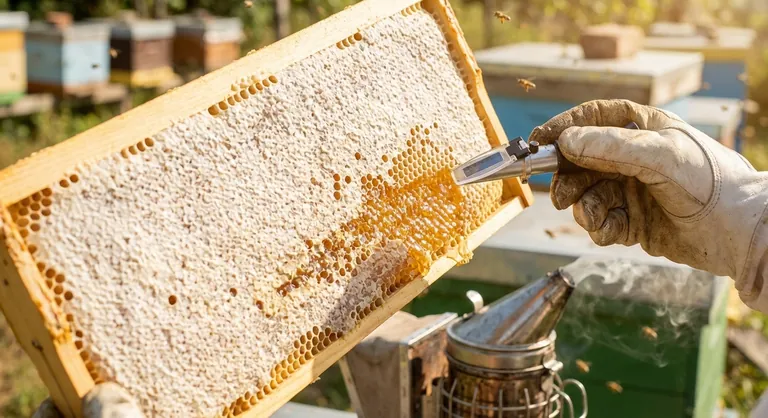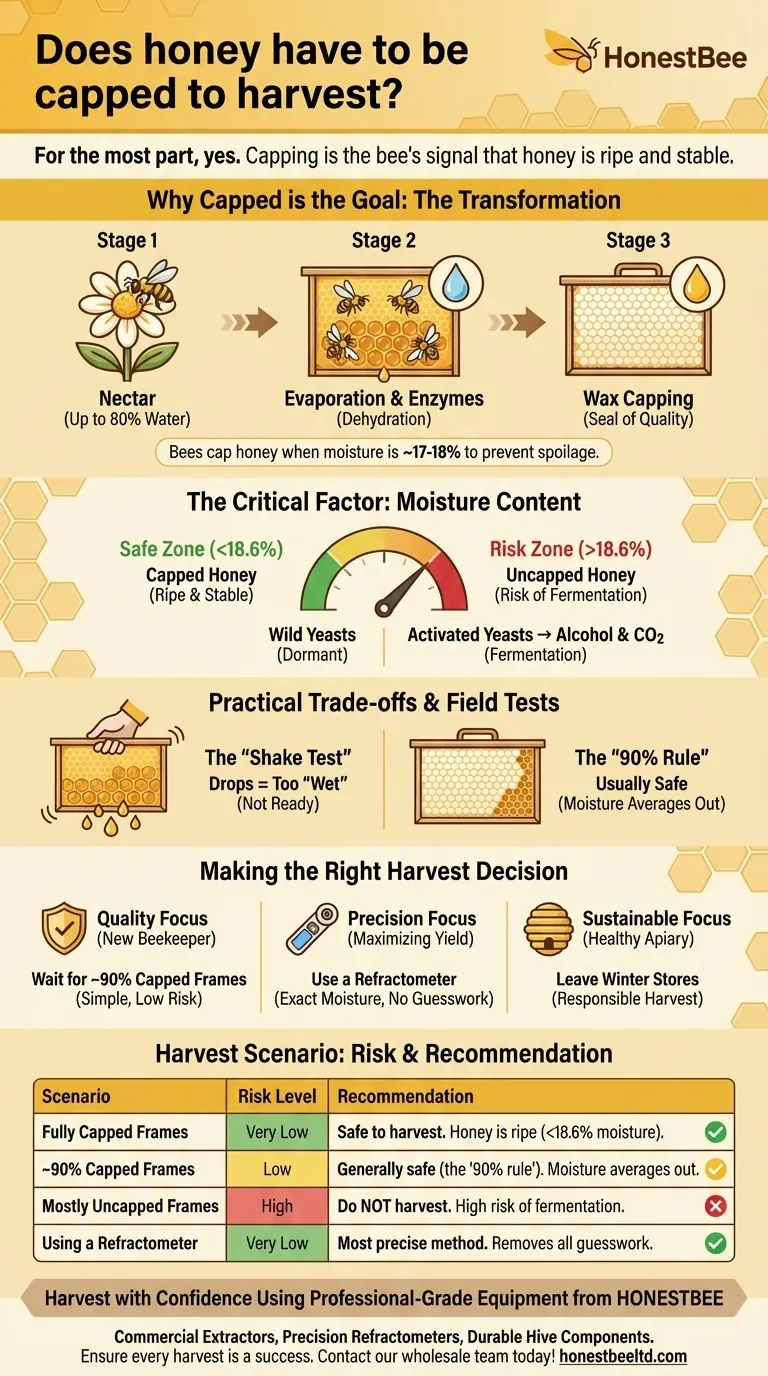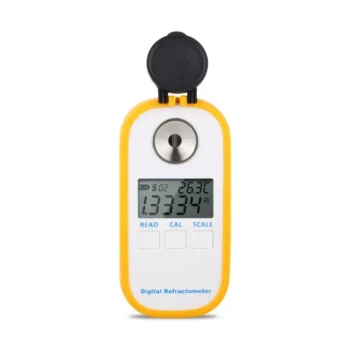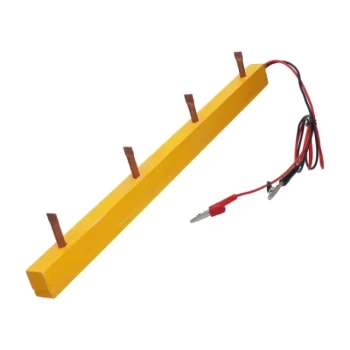For the most part, yes, your honey should be capped before you harvest it. The wax capping is the bees' signal that they have finished their work. It indicates the honey has been dehydrated to the proper moisture content and is now "ripe," meaning it is stable and will not ferment.
The core principle is that harvesting uncapped honey introduces a significant risk of spoilage. Capping is the final step in the bees' natural process of reducing the honey's moisture content to a level (below 18.6%) that prevents yeast from causing fermentation.

Why Capping is the Beekeeper's Green Light
To understand why capped honey is the goal, you must first understand how bees create it. This process is less about creation and more about transformation and preservation.
From Nectar to Honey
Bees begin with nectar, a liquid that can be up to 80% water. Through a process of enzyme addition and evaporation inside the hive, they actively reduce this water content.
The bees fan their wings over the nectar stored in the honeycomb cells, creating airflow that dehydrates it. This is a meticulous and energy-intensive process.
The Wax Cap: A Seal of Quality
Once the moisture content of the honey drops to its target level—typically around 17-18%—the bees place a pristine white wax seal over the cell.
This capping serves two purposes: it protects the finished honey from absorbing ambient moisture and it signals that the honey is fully cured and stable for long-term storage.
Identifying Unripe Honey
Frames that are not ready for harvest will have uncapped cells. If you look closely, you may see shining, wet nectar in these cells. This is a clear sign that the honey is not yet ripe and should be left for the bees to finish.
The Critical Factor: Moisture Content
The entire reason for waiting for cappings comes down to one crucial variable: the moisture content of your honey.
The Science of Fermentation
Wild yeasts are naturally present in honey. In their dormant state, they are harmless. However, if the water content in the honey is too high (above 18.6%), these yeasts can activate.
When activated, the yeasts begin to metabolize the sugars in the honey, producing alcohol and carbon dioxide. This process, fermentation, gives the honey a sour, undesirable taste and eventually causes it to spoil.
The Target Moisture Level
Properly cured and capped honey has a moisture content below 18.6%. This low water environment creates a hostile condition for microbes, which is why honey is so famously resistant to spoilage.
Harvesting uncapped honey means you are likely collecting honey with a moisture content of 20% or higher, making fermentation almost inevitable.
Understanding the Practical Trade-offs
While the rule is to harvest capped honey, experienced beekeepers know there are nuances. A perfect, 100% capped frame is not always achievable or necessary.
The "Shake Test"
A reliable field test is the "shake test." Hold a frame of partially uncapped honey flat over the top of the hive and give it a firm shake downwards.
If liquid nectar drips out of the cells, the honey is too "wet" and is not ready. If nothing comes out, the uncapped honey is likely close enough to the correct moisture content to be safe for harvest.
The 90% Rule
Many beekeepers follow a "90% rule." If a frame is at least 90% capped with wax, it is generally considered safe to harvest, especially later in the season.
The small number of uncapped cells will have their moisture content averaged out by the vast majority of properly cured honey in the extractor, usually keeping the final batch within a safe range.
The Risk of Being Too Eager
The primary pitfall is impatience. Harvesting too early in the year, when nectar is still flowing heavily, is particularly risky. This early-season nectar has a very high water content, and harvesting frames that are not fully capped almost guarantees a spoiled batch.
Making the Right Harvest Decision
Your approach to harvesting should be guided by your goals and your commitment to quality.
- If your primary focus is ensuring quality as a new beekeeper: Wait for your frames to be at least 90% capped before harvesting. This simple rule will protect you from the disappointment of fermented honey.
- If your primary focus is precision and maximizing yield: Invest in a honey refractometer. This tool allows you to test the exact moisture content of a sample of uncapped honey, removing all guesswork from your decision.
- If your primary focus is a sustainable apiary: Always ensure you are not just harvesting ripe honey, but also leaving enough stores for your bees to survive the winter. A responsible harvest is one that doesn't compromise the health of the colony.
Ultimately, trusting the bees' process is the surest path to harvesting high-quality, delicious honey that will last indefinitely.
Summary Table:
| Harvest Scenario | Risk Level | Recommendation |
|---|---|---|
| Fully Capped Frames | Very Low | Safe to harvest. Honey is ripe (<18.6% moisture). |
| ~90% Capped Frames | Low | Generally safe (the '90% rule'). Moisture averages out. |
| Mostly Uncapped Frames | High | Do NOT harvest. High risk of fermentation. |
| Using a Refractometer | Very Low | Most precise method. Removes all guesswork. |
Harvest with Confidence Using Professional-Grade Equipment from HONESTBEE
As a commercial apiary or beekeeping equipment distributor, the quality of your harvest directly impacts your brand and profitability. Don't leave it to chance. HONESTBEE supplies the durable, high-performance equipment you need to ensure every harvest is a success.
We provide wholesale-focused operations with:
- Commercial Extractors & Uncapping Tools for efficient, large-scale processing.
- Precision Refractometers to eliminate guesswork and guarantee perfect moisture levels.
- Durable Hive Components & Protective Gear to support healthy, productive colonies.
Let's discuss how our beekeeping supplies can help you maximize yield and maintain superior quality. Contact our wholesale team today to request a catalog or discuss your specific needs.
Visual Guide

Related Products
- Precision Honey Refractometer Instrument for Quality Assessment
- Digital Honey Refractometer for Precision Measurement of Optimal Honey Quality
- HONESTBEE 72 Frame Industrial Electric Honey Extractor for Beekeeping
- 6 Frame Manual Stainless Steel Honey Extractor Beekeeping Equipment
- HONESTBEE 6 Frame Three Use Electric Honey Extractor for Beekeeping
People Also Ask
- Why is a honey refractometer important for beekeepers? Ensure Quality and Prevent Fermentation
- How does a honey refractometer work? Ensure Honey Quality & Harvest Readiness
- Why is a honey refractometer essential for honey harvesting? Protect Your Harvest from Spoilage
- Why is a honey refractometer considered essential for commercial beekeepers? Ensure Honey Quality and Profitability
- What is a honey refractometer and what is its purpose? Ensure Honey Quality and Prevent Spoilage



















